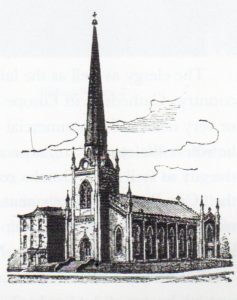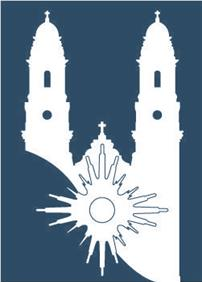The Second Cathedral

A committee, composed of Messrs. James Creighton, F.X. Dellone, and Vincent Burkley was appointed by Bishop O'Gorman to assist him in selecting a suitable location for the new structure. The location, however, was readily decided upon when Edward Creighton purchased two lots next to the Bishop's residence and donated them to the Church. Ninth and Harney streets would be the location of the new Saint Philomena Cathedral.
Because Omaha City had grown tremendously and was now bounded by Fifteenth street on the west, Douglas on the north, and Pierce on the south, the site of the new cathedral was considered an ideal location. It was in the heart of the business activity and surrounded by the largest hotels in the town.
Building on the new cathedral began in 1866; but, only a few months later, construction was halted for lack of funds. It was then that Bishop O'Gorman initiated another first - - the first fund-raising drive of the Catholic church in Nebraska. Not only were the Omaha townsmen solicited for contributions, Father William Kelly was also commissioned by the Bishop to solicit funds throughout the eastern United States for the proposed cathedral.
Father Kelly, journeying far and side, visited many eastern cities, mining camps, and railroad construction camps in his travels; and, on his return six months later, had collected fifteen thousand dollars.
Historians report that the efforts of Father Kelly were remarkably successful. Eugene Hagedorn, OFM, in his book The Franciscans in Nebraska, related an incident in a mining camp: "Entering a dance hall in a mining camp one day, one of the men demanded to know what he (Father Kelly) was doing there. 'I am collecting for a new cathedral in Omaha,' was the reply. Thereupon the Western man doffed his hat, drew his trusty six-shooter, and accompanied the astonished priest around the room, thus obtaining more than a hatful of money through this 'persuasive' method."
With fifteen thousand dollars now in the church coffers, a full scale building program for the cathedral was launched. The cornerstone was laid in the spring of 1867 with twenty-five hundred people present to witness the event, and by the spring of 1868 the dedication ceremony was held.
The new cathedral, at Ninth and Harney, with its high steeple and walls of stone, was officially placed under the patronage of Saint Philomena, and boasted a fine marble altar sculptured in Italy, a large pipe organ, the first of its kind in Omaha City, and a large triple stained-glass window of the "Crucifixion" in back of the altar.
With the new cathedral now finished, Saint Mary's was turned over to the Sisters of Mercy for a school; and, as Holy Angels school, served the parish for many years. Land was also purchased at Twenty-fourth and Saint Mary's Avenue for one hundred fifty dollars for the Sisters, and thereupon Saint Mary's convent and all-girls school was erected. Saint Mary's avenue received its name from this event in history.
The structure itself was a three-story brick building, one of the few brick buildings in Omaha at the time, and cost a reputed ten thousand dollars. Taxing the Bishop's resources to the utmost, he again dispatched his favorite solicitor, Father William Kelly, to Saint Louis to collect money for the project. The Catholics of Omaha, in order to help finance the new convent, initiated another first for raising money in the Catholic church - - the church festival. The festival of 1864 raised almost a thousand dollars.
